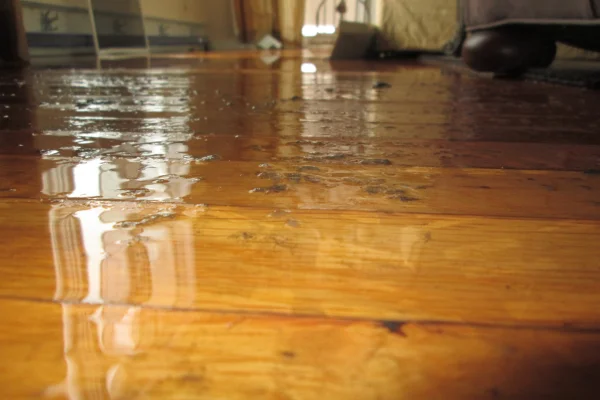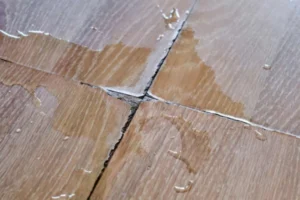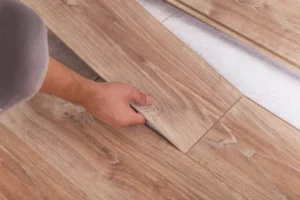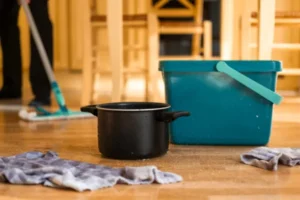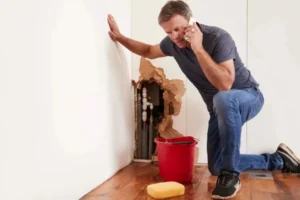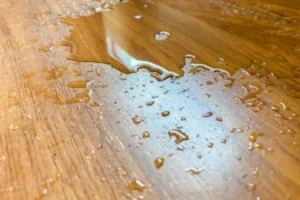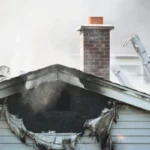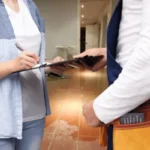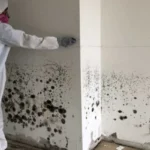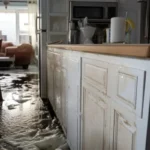Water damage in high-moisture spaces can turn your dream home into a costly headache. Kitchens, bathrooms, basements, and laundry rooms are especially vulnerable. Moisture seeps in through leaks, condensation, and poor drainage, weakening floors and inviting mold growth.
Protecting your investment means more than choosing beautiful flooring—it’s about thoughtful planning, the right materials, and regular maintenance. So, what steps can you take to guarantee your floors remain protected from lurking moisture? In this guide, we’ll explore steps to prevent water damage, from identifying early warning signs to long-term strategies that keep your home safe and dry.
Water-damaged floors can quickly worsen if ignored. Damaged floors weaken a home’s structure and value. Dealing with water damage requires fast action. Now is a great time to learn more about how to prevent water damage and protect floors from water damage with expert repair and maintenance tips. Let’s take a deeper dive now!
Understanding Water Damage in High-Moisture Areas
When water-damaged floors appear, it’s essential to address them quickly. Damaged floors may spread problems throughout your home. Dealing with water damage effectively includes knowing how to prevent water damage and how to protect floors from water damage long-term.
Before you can protect your floors, you need to know where and why water damage happens. High-moisture environments create perfect conditions for damage if left unchecked.
Common Causes of Water Damage
Water problems often sneak up on homeowners. Here are three frequent culprits:
- Leaky pipes hidden behind walls or under sinks or even in ceilings and floors.
- Poor basement water control, allowing moisture to seep through foundations.
- Condensation buildup on surfaces due to high humidity.
Addressing these causes is your first step in learning how to prevent water damage effectively.
Areas of the Home Most at Risk
Bathrooms, kitchens, and basements are constantly exposed to water from plumbing fixtures, spills, and humidity. Laundry rooms also pose risks, such as overflowing machines or hose leaks. These areas require extra attention and innovative preventive measures to keep the flooring intact.
Signs of Early Water Damage
You may not always notice the subtle signs of early water damage, but being aware of them can save your floors from major problems down the road. Catch problems before they escalate. Watch for:
- Dark stains or discoloration in walls and ceilings.
- A persistent musty smell despite cleaning and spraying.
- Warping or buckling floorboards underfoot.
Early detection can save you thousands in repairs.
Choosing the Right Flooring Materials
Flooring choices play a critical role in moisture control. Durable, moisture-resistant flooring can make all the difference.
Water-Resistant and Waterproof Flooring Options
Selecting the right flooring materials is essential, especially in areas prone to moisture. Consider these options:
- Luxury Vinyl Plank (LVP): Stylish, completely waterproof, and easy to maintain.
- Tile: Ideal for bathrooms and kitchens, offering superior durability.
- Water-resistant laminate: Affordable and practical for high-traffic areas.
Hardwood vs Engineered Wood in Moist Areas
Traditional hardwood swells when exposed to water, making it risky for damp environments. Engineered wood, with its layered structure, resists moisture better. If you opt for wood, ensure that you seal it and maintain it properly.
Tile, Vinyl, and Laminate Solutions
Tile remains the gold standard for wet spaces, while vinyl delivers flexibility and cost savings. Laminate works well in living areas, but make sure it includes a water-resistant core for added protection.
Preventive Measures and Best Practices
Even the best flooring won’t last without good habits and infrastructure. Here’s how to safeguard your home:
Installing Proper Drainage Systems
Installing proper drainage systems is crucial for preventing water damage to your floors, especially in areas prone to heavy rainfall or flooding. Get around this by investing in:
- French drains to redirect water away from foundations.
- Gutters and downspouts for proper rainwater flow.
- Sump pumps in basements for effective water removal.
Using Sealants and Protective Coatings
While water damage can be devastating, applying sealants adds an invisible shield against moisture. To maintain protection, reapply as recommended for your flooring type and inspect regularly.
Maintaining Proper Humidity Levels
Maintaining proper humidity levels in your home is another essential step in countering water damage. Keep indoor humidity between 30–50% by:
- Running dehumidifiers in basements.
- Using exhaust fans in kitchens and bathrooms.
- Checking for leaks near windows and pipes.
Regular Inspection and Maintenance
To effectively prevent water damage, regular inspection and maintenance of your floors is highly recommended. Inspect monthly for leaks, mold, or cracks. Quick action helps stop minor issues from becoming major problems.
DIY Water Damage Prevention Tips
When it comes to minimizing water damage, small actions make a big difference. These DIY tips can save you time and money in the long run:
Immediate Actions to Stop Water Spills
Follow these steps to minimize damage:
- Blot spills immediately with absorbent towels.
- Use a wet/dry vacuum for larger messes.
- Speed up drying using fans and open windows.
Using Mats and Barriers in Wet Areas
After addressing immediate spills, it’s essential to consider long-term measures for preventing water damage. Place absorbent mats near sinks, tubs, and entryways. Install water barriers where needed to block splashes and drips.
Quick Cleanup Methods to Avoid Floor Damage
Act swiftly whenever spills occur and follow the absorb–rinse–dry routine:
- Absorb with towels to remove water.
- Wipe with a damp cloth to clean off debris.
- Dry thoroughly to avoid moisture buildup.
When to Call a Professional
When you notice signs of water damage, it’s helpful to know when to call a professional. Not all problems can be solved with a towel and a fan.
Signs That Require Expert Intervention
If you notice any of the following, it’s time to call a professional:
- Warped floorboards or spongy spots underfoot.
- Lingering smells that do not go away.
- Visible mold growth and signs of mildew.
Benefits of Professional Moisture Control
Specialists utilize advanced tools to identify hidden leaks and apply targeted solutions, thereby reducing future risks and saving you money in the long term.
Hiring Certified Water Damage Specialists
Water damage can escalate quickly, making it crucial to act promptly. Choose professionals who offer:
- Advanced moisture detection tools.
- Industrial drying equipment.
- Comprehensive restoration plans.
Preventing Mold and Long-Term Damage
Unchecked moisture leads to mold, which affects both your floors and indoor air quality. Stay vigilant and bring in experts at the first sign of trouble.
Long-Term Floor Protection Strategies
To keep your floors safe from water damage in the long run, you need effective protection strategies.
Using Dehumidifiers and Ventilation Systems
Try implementing these:
- Dehumidifiers: Use to remove excess moisture, keeping humidity levels in check.
- Exhaust Fans: Utilize them in moisture-prone spaces to expel humid air.
- Air Vents: Guarantee proper airflow to prevent stagnant, damp conditions.
Seasonal and Routine Maintenance
Inspect during seasonal changes and repair cracks or gaps promptly. Clean up spills immediately and keep drainage systems clear.
Educating Household Members on Preventive Practices
Share these tips with your family to make moisture control a team effort:
- Wipe up spills immediately to avoid water from seeping into the floor.
- Use door mats to trap moisture and dirt to prevent tracking through the home.
- Use furniture coasters to prevent scratches and moisture buildup underneath.
Prevent Water Damage to Floors – Final Thoughts
Combine durable materials, proper drainage, humidity control, and routine inspections for a powerful defense. And when issues arise, call the experts before damage spreads.
Homeowners facing water-damaged floors know the risks of neglected damaged floors. Dealing with water damage is easier when you understand how to prevent water damage. Protect floors from water damage with timely repairs, preventative care, and reliable professional restoration solutions.
In need of help? Schedule a consultation and keep your home safe, dry, and beautiful for years to come. Protect Your Floors from Costly Water Damage – Contact Our Experts Today!

